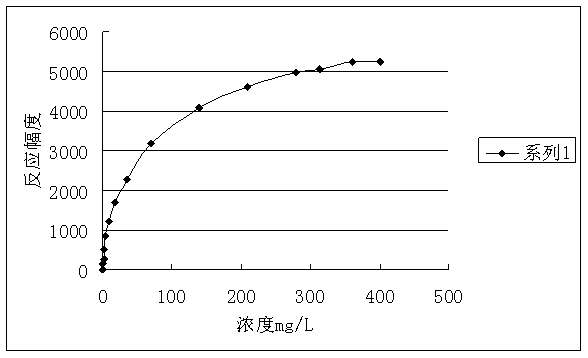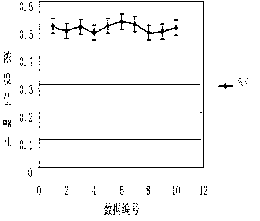Antibody conjugate and method thereof
An antibody conjugate, antibody conjugation technology, applied in measurement devices, instruments, scientific instruments, etc., can solve problems such as low coupling efficiency, low antibody coupling efficiency, and difficulty in finding coupling conditions, and achieve reaction conditions. The effect of mildness, improved coupling conditions, and increased sensitivity
- Summary
- Abstract
- Description
- Claims
- Application Information
AI Technical Summary
Problems solved by technology
Method used
Image
Examples
Embodiment 1
[0048] 1. Clean the latex, wash twice with 0.05M, pH5.5 MES buffer; the size of the selected latex is 80nm;
[0049] 2. Add NHS and EDC 10 times the molar number of latex-COOH to the washed latex, and react for 30 minutes at room temperature under vigorous stirring;
[0050] 3. After centrifugation at low temperature (4°C), discard the supernatant and redissolve with activation buffer; repeat this step twice, discard the supernatant after the last centrifugation, do not redissolve, and set aside;
[0051] 4. Dilute the antibody to 1.2mg / ml with 0.04M, pH7.2 phosphate buffer, namely the reaction buffer;
[0052] 5. Reconstitute the activated latex with deionized water, the concentration is 10mg / ml, and quickly add the reconstituted latex to the antibody diluted in equal volume;
[0053] 6. React for 4 hours under room temperature and vigorous stirring;
[0054] 7. After centrifugation at low temperature (4°C), suck out the supernatant, and put the supernatant into a centrifug...
Embodiment 2
[0058] 1) Choose the size of latex as 120nm. Dilute the latex to 10 mg / ml with the activation buffer, remove the supernatant after centrifugation; redissolve the precipitate with the activation buffer to 10 mg / ml;
[0059] 2) Centrifuge the solution obtained in step 1 at 4°C, remove the supernatant, and redissolve the precipitate with the activation buffer to 10 mg / ml;
[0060]3) To the latex obtained in step 2, add NHS and EDC 5-15 times the number of moles of carboxyl groups in the latex, and stir vigorously at room temperature for 15-30min;
[0061] 4) Centrifuge the solution obtained in step 3 at 4°C, remove the supernatant, and redissolve the obtained precipitate with the activation buffer;
[0062] 5) After repeating step 4 twice, centrifuge at 4°C to remove the supernatant and set aside;
[0063] 6) Dilute the antibody to 1-6 mg / ml with the reaction buffer;
[0064] 7) Reconstitute the latex obtained in step 5 with deionized water to a concentration of 10 mg / ml; quic...
Embodiment 3
[0076] Verification of coupling efficiency: ①Use the absorbance at 260nm and 280nm of the UV spectrophotometer to determine a standard curve of antibody concentration; ②Use the UV spectrophotometer at 260nm and 280nm to measure the absorbance of the antibody before and after coupling respectively; ③Use the standard of antibody concentration Curve to calculate the antibody concentration before and after coupling; ④Divide the antibody concentration after coupling by the antibody concentration before coupling to calculate the percentage, and then subtract the calculated percentage from 1 to obtain the coupling efficiency; ⑤This type of coupling The antibody coupling efficiency of the coupling method can reach about 90%.
[0077] Table 1: Coupling efficiency
[0078]
PUM
| Property | Measurement | Unit |
|---|---|---|
| particle diameter | aaaaa | aaaaa |
| concentration | aaaaa | aaaaa |
Abstract
Description
Claims
Application Information
 Login to View More
Login to View More - Generate Ideas
- Intellectual Property
- Life Sciences
- Materials
- Tech Scout
- Unparalleled Data Quality
- Higher Quality Content
- 60% Fewer Hallucinations
Browse by: Latest US Patents, China's latest patents, Technical Efficacy Thesaurus, Application Domain, Technology Topic, Popular Technical Reports.
© 2025 PatSnap. All rights reserved.Legal|Privacy policy|Modern Slavery Act Transparency Statement|Sitemap|About US| Contact US: help@patsnap.com



